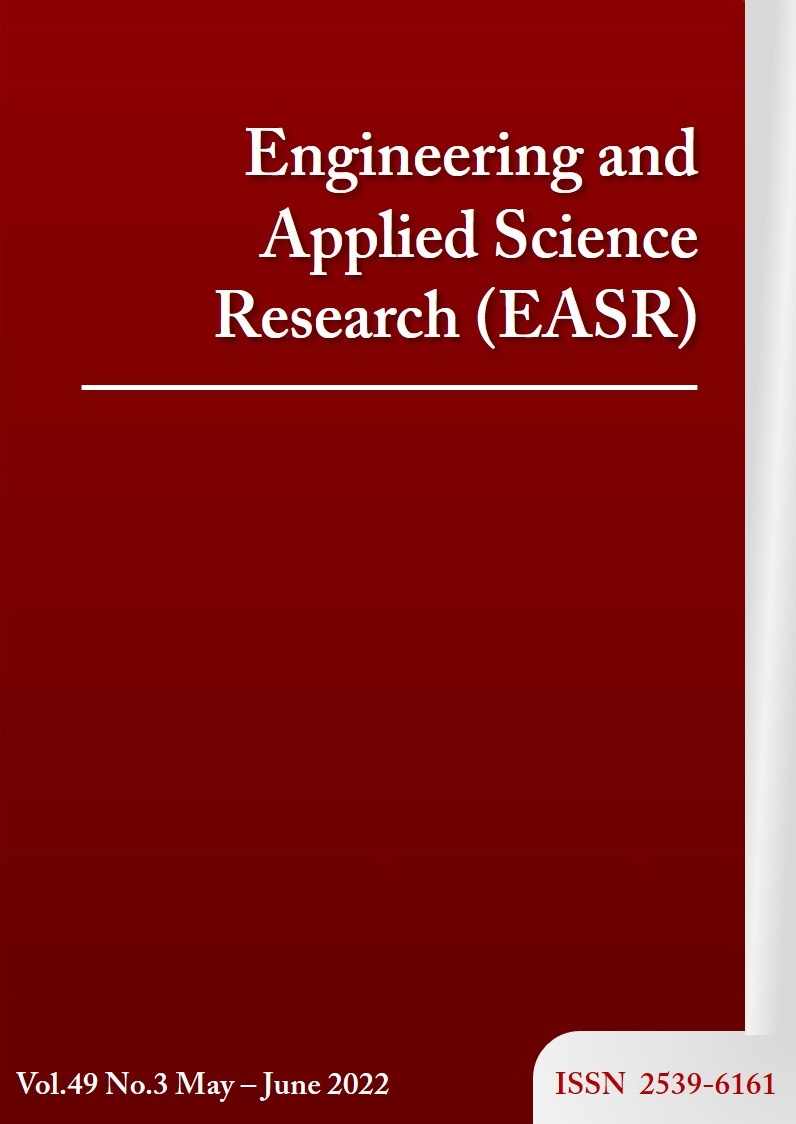Design and development of natural-draft Ethanol/LPG burner for heavy-duty cooking
Main Article Content
Abstract
A natural-draft, heavy-duty cooking burner was designed and developed as a fuel-flexible burner capable of burning both liquefied petroleum gas (LPG) and Ethanol. The burner has great potential to replace LPG with ethanol to reduce the consumption of fossil fuels. Ethanol is a renewable fuel; it can be produced domestically from agricultural products. However, its heating value is lower than that of LPG. Thanks to the advantage of combustion in a porous medium to create heat recirculation, the flame temperature is higher than that of the free flame. Using a column embedded in the burner wall, liquid ethanol is vaporized without external heating and atomization. A critical criterion for the burner is to stabilize the flame inside the porous medium so that flow velocity equals burning velocity. A common gas injector can be used to switch between LPG and ethanol while maintaining better combustion and thermal performance compared to a conventional LPG burner and previous ethanol burners. The proposed burner has a compact combustion chamber, but it yields a higher combustion temperature because it stabilizes the flame at greater amounts of primary air with a high turn-down ratio.
Article Details
This work is licensed under a Creative Commons Attribution-NonCommercial-NoDerivatives 4.0 International License.
References
Energy policy and planning Office. Energy database [Internet]. 2020 [updated 2020 Dec10; cited 2021 Jun 10]. Available from: http://www.eppo.go.th/info/index.html.
Department of alternative energy development and efficiency ministry of energy. Ethanol [Internet]. 2021 [updated 2021 Mar19; cited 2021 Jun 10]. Available from: https://www.dede.go.th/more_news.php?cid=81&filename=index.
Agarwal AK. Biofuels (alcohols and biodiesel) applications as fuels for internal combustion engines. Progr Energ Combust Sci. 2007;33(3):233-71.
Gnanamoorthi V, Devaradjane G. Effect of compression ratio on the performance, combustion and emission of DI diesel engine fueled with ethanol-diesel blend. J Energ Inst. 2015;88(1):19-26.
He BQ, Liu M, Zhao H. Comparison of combustion characteristics of n-butanol/ethanol-gasoline blends in a HCCI engine. Energ Convers Manag. 2015;95:101-9.
Bayraktar H. Experimental and theoretical investigation of using gasoline-ethanol blends in spark-ignition engines. Renew Energ. 2005;30(11):1733-47.
Rajvanshi AK, Patil SM, Mendonca B. Low-concentration ethanol stove for rural areas in India. Energ Sustain Dev. 2007;11(1):94-9.
Bizzo WA, de Calan B, Myers R, Hannecart T. Safety issues for clean liquid and gaseous fuels for cooking in the scope of sustainable development. Energ Sustain Dev. 2004;8(3):60-7.
Robinson J. Bio-Ethanol as a household cooking fuel [thesis]. UK: Loughborough University; 2006.
Stokes H, Ebbeson B. Project Gaia: commercializing a new stove and new fuel in Africa. Boiling Point. 2005;(50):31-3.
The Ashden Awards for Sustainable Energy. Clean, Safe Ethanol Stoves for Refugee Homes [Internet]. 2008 [updated 2008; cited 2008 Jun 10]. Available online from: https://www.raonline.ch/pages/edu/dev/ashden0801.html.
Choi SK, Choi YS, Kim SJ, Jeong YW. Characteristics of flame stability and gaseous emission of bio-crude-oil/ethanol blends in a pilot-scale spray burner. Renew Energ. 2016;91:516-23.
Wang G, Tang P, Li Y, Xu J, Durst F. Flame front stability of low calorific fuel gas combustion with preheated air in a porous burner. Energy. 2019;170:1279-88.
Song F, Wen Z, Dong Z, Wang E, Liu X. Ultra-low calorific gas combustion in a gradually-varied porous burner with annular heat recirculation. Energy. 2017;119:497-503.
Wood S, Harris AT. Porous burners for lean-burn applications. Progr Energ Combust Sci. 2008;34(5):667-84.
Liu H, Wu D, Xie M, Liu H, Xu Z. Experimental and numerical study on the lean premixed filtration combustion of propane/air in porous medium. Appl Therm Eng. 2019;150:445-55.
Weinberg FJ. Combustion temperature: the future. Nature. 1971;233(5317):239-41.
Panigrahy S, Mishra SC. Analysis of combustion of liquefied petroleum gas in a porous radiant burner. Int J Heat Mass Tran. 2016;95:488-98.
Keramiotis C, Stelzner B, Trimis D, Founti M. Porous burners for low emission combustion: an experimental investigation. Energy. 2012;45(1):213-9.
Mishra NK, Muthukumar P. Development and testing of energy efficient and environment friendly porous radiant burner operating on liquefied petroleum gas. Appl Therm Eng. 2018;129:482-9.
Deb S, Muthukumar P. Development and performance assessment of LPG operated cluster porous radiant burner for commercial cooking and industrial applications. Energy. 2020;219:119581.
Kaushik LK, Muthukumar P. Life cycle assessment (LCA) and techno-economic assessment (TEA) of medium scale (5-10 Kw) LPG cooking stove with two-layer porous radiant burner. Appl Therm Eng. 2018;133:316-26.
Devi S, Sahoo N, Muthukumar P. Experimental studies on biogas combustion in a novel double layer inert porous radiant burner. Renew Energ. 2020;149:1040-52.
Kaushik LK, Muthukumar P. Thermal and economic performance assessments of waste cooking oil/kerosene blend operated pressure cook-stove with porous radiant burner. Energy. 2020;206:118102.
Makmool U, Pontree K, Jugjai S. Design and development of a novel self-aspirating liquid fuel annular porous medium burner (SLAPMB). Fuel. 2017;192:83-92.
Trimis D, Durst F. Combustion in a porous medium-advances and applications. Combust Sci Tech. 1996;121(1-6):153-68.
Chaelek A, Grare UM, Jugjai S. Self-aspirating/air-preheating porous medium gas burner. Appl Therm Eng. 2019;153:181-9.
Addamane SR, Hajilou M, Belmont EL. Experimental and analytical study of a porous media reformer with passive air entrainment. Int J Hydrogen Energ. 2016;41(30):12738-46.
Thailand Industrial Standard Institute (TISI). Domestic gas stoves for use with liquefied petroleum gas: TIS 2312-2549. Bangkok: TISI; 2006.
Jugjai S, Rungsimuntuchart N. High efficiency heat-recirculating domestic gas burners. Exp Therm Fluid Sci. 2002;26(5):581-92.
Taylor J. Introduction to error analysis: the study of uncertainties in physical measurements. 2nd ed. USA: University Science Books; 1997.
European commission. Preparatory studies for eco-design requirements of EuPs (III): lot 23 domestic and commercial hobs and grills, included when incorporated in cookers. Paris: Bio-Intelligence Service; 2010.
Fenimore CP. Formation of nitric oxide in premixed hydrocarbon flames. Symp (Int) Combust. 1971;13(1):373-80.
Energy Policy and Planning Office. Energy statistics [Internet]. 2020 [updated 2020 Dec 4; cited 2021 Jun 10]. Available from: http://www.eppo.go.th/index.php/th/component/k2/item/16366-energy-statistics-2563.



